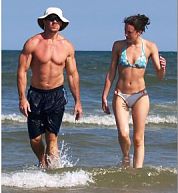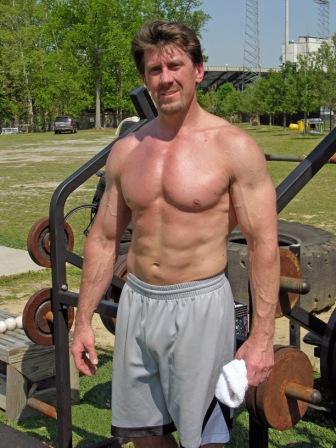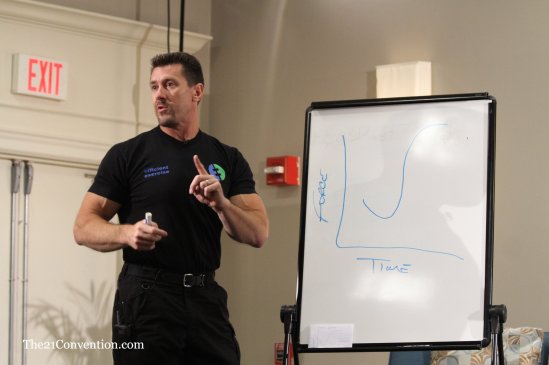So, just how does one go about juggling a comprehensive diet and exercise regimen with a full plate of family commitments and a demanding, 45-hour a week work life? That’s what I hope to chronicle in this blog — my day-to-day attempt at applying solid diet and fitness related theory within the constraints of a real-world life.
I’ve been a “Physical Culturalist” for well over thirty years, now — the majority of those years while holding down demanding jobs completely outside of the fitness industry. And I happen to know a secret that most people who’ve attempted to implement a health and fitness program within a normal, work-a-day life have no doubt figured out — that it’s not the rather truncated list of “what to do’s” that’ll ultimately doom you — hell, there’s a plethora of solid, well-researched information out there just for the asking; the real implantation killers lay hidden within the din of the consistent, day-in and day-out roadblocks that serve to prevent the application of that information. It’s not for lack of desire or inspiration that the majority people fail at their fitness goals; failure ultimately results from the cumulative fatigue inflicted from the springing of life’s little boobi-traps. Day-to-day trip-ups that’ll dis-inspire and frazzle one’s resolve. With this blog, I’ll attempt to shed some light on how I “endeavor to persevere” in my quest for the ultimate expression of Physical Culture; that is, producing the best, most healthful physical expression that my personal genetic hand is capable of achieving.
In September of 2010, I made good on a long-standing promise to myself that I would one day, when the call became clear and apparent, become more fully engaged in the hands-on teaching of my personal method for achieving what I term the “Physical Culture high life”; once I was introduced to the Efficient Exercise team, learned of their overriding philosophy of Physical Culture (and how closely that philosophy parallelled my own!), and was subsequently offered a position within the team, I knew that no clearer “call” could be had. This was the signal I’d been waiting for, and I jumped at the opportunity; I am now manager of Efficient Exercise’s Rosedale studio where I’m delighted to share my years of Physical Culture know-how in an intimate, one-on-one setting. So if you happen to be in the Austin, Texas area (the epicenter of Physical Culture!), I do hope you’ll make an appointment to see me. Little satisfies me more than to partner with a client and, together, see that their health and fitness goals are attained. Whether you’re an athlete, stay-at-home mom, or corporate ladder-climber, we at Efficient Exercise can see that you attain your own self-defined version of the Physical Culture high-life.
 So I do hope that you’ll drop by the Theory to Practice blog now and again to pick up some valuable tips and maybe — hopefully! — you’ll see that it is actually possible to be fit, well-fed and healthy even while being a slave to the capitalist grind. Also, feel free to drop by the Efficient Exercise blog, where my Efficient Exercise team members and I dish on diet, exercise and all things Physical Culture, with a decidedly Austin, Texas flair. And by all means, if you have any tips to share — questions, comments, or concerns as well — please feel free to drop me a line at either theorytopractice@gmail.com, or keith@efficientexercise.com — I’d love to hear from you! I’ve no PhD. nor laundry-list of acronyms following my name to tout; I do, however, have 30+ years of in-the-trenches warfare, empirical and self-taught knowledge at my disposal. I am by no means a “certified expert” in anyone’s ledger, just a guy who’s become demonstrably adept at consistently stiff-arming life’s obstacles so as to eek-out a damn good work-out and a healthy, tasty meal. Put a string of those types of “wins” together, and before long you’ve established a solid leg-up in the ol’ Physical Culture game.
So I do hope that you’ll drop by the Theory to Practice blog now and again to pick up some valuable tips and maybe — hopefully! — you’ll see that it is actually possible to be fit, well-fed and healthy even while being a slave to the capitalist grind. Also, feel free to drop by the Efficient Exercise blog, where my Efficient Exercise team members and I dish on diet, exercise and all things Physical Culture, with a decidedly Austin, Texas flair. And by all means, if you have any tips to share — questions, comments, or concerns as well — please feel free to drop me a line at either theorytopractice@gmail.com, or keith@efficientexercise.com — I’d love to hear from you! I’ve no PhD. nor laundry-list of acronyms following my name to tout; I do, however, have 30+ years of in-the-trenches warfare, empirical and self-taught knowledge at my disposal. I am by no means a “certified expert” in anyone’s ledger, just a guy who’s become demonstrably adept at consistently stiff-arming life’s obstacles so as to eek-out a damn good work-out and a healthy, tasty meal. Put a string of those types of “wins” together, and before long you’ve established a solid leg-up in the ol’ Physical Culture game.
Come join in the journey; it’s a hell of a fun — and rewarding — ride!
In health –
Keith


You’re extremely handsome and have a very nice body. I’m very impressed, you certainly take care of yourself.
Sandy
sandystills72@gmail.com
Nice site. I’ll check in from time to time. Good to see you at the beach and will try to be there next year.
Mike
Pingback: GO HEALTHY GO FIT » Blog Archive » Can you attain a muscular physique by eating Paleo?
Keith,
I recently discovered your site through your plug on Noodlefood. I’ve been enjoying reading your past posts. You’ve mentioned San Antonio a few times and that’s where I am originally from. Born there in ’74 and moved to Atlanta in ’95. I went to Madison high school. I wish I could have had you as trainer back then. I look forward to reading more of your posts.
Welcome aboard, Aquinas. I’ve got quite a few ties to Madison, however, they were long gone by the time you came through. I played ball at Texas State with Rusty Cooper and Greg Hagen (both class of ’83) and I dated a girl named Erin Polumbo (class of ’82). I know Erin still lives in San Antonio — I’m not sure about Rusty and Greg. In fact, Erin had a younger brother that might have been at Madison when you were there — his name was Adam Polumbo. I’m not sure that I’ve got the spelling of the last name exactly right, though.
I’m glad you’re enjoying the blog. I’ve had a blast writing it and interacting with like-minded folks. I also really enjoy Noodlefood & I need to get it on my blog roll.
Keith,
I have enjoyed following your posts on My Yahoo. Just wondering if you were aware of any reason why the posts have not updated on My Yahoo starting 2 months ago. That service seems to have its quirks. Most blogs with RSS feeds seem to update normally, but occasionally, one just stops.
I also use Snarfer and your blog updates normally in that reader.
Anyway, I enjoy the posts.
Hmmm. Not sure about the Yahoo glitch, Mike. Thanks for the heads-up. And thanks, as well, for the good words.
You look great dude. Really like that I found your blog via the Zen to Fitness blog.
Yavor
Hey, Keith. Great blog.
I have been trying, in vain, to develop some concise information on an IF schedule for myself.
In general, I find it hard to clarify when I should fast — and even when I *should* time eating, with respect to working out and sleep schedules.
There is so much information out there, and I’ve made a bunch of chagnes myself over the last several months.
Can you help with some resources or ideas about fasting and general eating timing?
Thanks!
dg,
First off, my advice is not to attempt phasing in IF until you’ve got a firm handle on the Paleo lifestyle established — that is, at least until your body has “re-learned” to operate efficiently in a ketogenic environment. Secondly, I don’t prescribe to the notion that either meals or IF should be “timed” in any way (I’ve got a post on this forthcoming). I think the natural order of both scarcity and super-compensation is described by randomness. Personally, I go as much as possible by what my natural hunger dictates. And I say “as much as possible” only because I must somewhat align (begrudgingly) to a corporate schedule, at least during the week. If I were completely free of that constraint, I’d go totally by what my natural hunger impulse dictated. Same goes with IF; just go with the flow. And remember, you don’t have to fast for a full 24-hours — there’s no magic associated with that number, per se. The magic is in recognizing, listening, and responding to your body’s own rhythms and needs.
Keith,
I probably shoudl have written more. I adopted a Paleo eating style about 5 months ago. I have blended this protocol with aspects of the Metabolic Diet (that mostly being the weekend card binge) and general daily eating timing of concepts in the Leptin Diet (that being to space daily meals at least 5 hours apart, to get to bed well after your last mean, to get enough sleep, and to allow the body to fast from dinner to breakfast). etc. So, here I am incorporating a 4th protocol (IF) after a long period of research into it. To answer your recommendations, I am vested into a Paleo style.
What I’ve found in the IF community is a huge variation in approach. To some, the fast means one large meal a day. To others, it’s 36 hours every 7 days, with a hard workout at the end of that 36. There’s every possible combination represented besides.
For me, the IF concept is most interesting as it applies to longevity. After that, it looks somewhat useful for fat liberation. For the former concept, timing and duration with respect to total annual consumption are readily interpretable: eat less and expose cells to less eating-induced stressors. For the latter concept the variables seem to be more touchy?
I would guess that aiming for longevity is a legit goal (for me) and tweaking in pursuit of other goals might fall in place.
dg,
I can’t really speak to the specific timing protocols, as I’ve never incorporated them myself. I’m more of a real-world applications guy, so when the idea of rigid timing schedules comes up, I tend to tune out, because, realistically, I’d never be able to fully apply it in my life. It’s about all I can do to get to the gym a few days a week and eat properly 🙂 Now granted (and because of my life situation), I’ve probably got a bit of cognitive bias here, but I truly believe that the random method is the best, healthiest and most natural way to approach both meal timing and meal volume. That’s not to say that I feel there is no value in the timing issue. If I were a competitive athlete, and had both the time and monetary incentive to do so, I’d invest more time in the investigation and (possible) implementation of these protocols.
Keith, my goal is to look somewhat like you in a few months. I dont have the genetics to be that muscularly dense, but I’ll come into my own….How much do you train per week?
Minneapolis J,
Check out my various “Workouts for the Week of…” posts. I don’t do anything more than what I report in these posts.
Keith, do you have an email address? I want to show you a progress pic.
MinnJ,
Hit me up at theorytopractice@gmail.com. Let’s see the progress!
Pretty cool post. I just stumbled upon your blog and wanted to say
that I have really liked reading your blog posts. Anyway
I’ll be subscribing to your blog and I hope you post again soon!
I just had to say how much I enjoy your blog and your explanations on training theory…. Primal!
What a great site! You really have put it all into practice and achieved some very impressive results! Great inspiration, I will be keeping up to date with your latest theories and recommendations.
Amazing blog. You’ve done a great job keeping it interesting. I especially enjoy the tone in which you write.
Keep up the good work.
Any tips on how to maintain such great longevity? (blogging)
Brian
http://www.hardgainer-transformation.com
Thanks for the kudos, Brian. Longevity in blogging? Speak the truth, and keep it real. Same as in real life.
I’m your newest fan, Keep up the good work!
Just wanted to drop you a line and say that I am so glad I have discovered your website.
You look awesome! Clear dedication and a job well done.
Are you on Facebook by any chance?
Greets from The Netherlands
never mind! I have found you on facebook!silly me, should have looked a bit further!
Glad you found me, Carla; thanks for the good words!!
Dear Keith Norris (and his fans)
My name is nate (im 18) and my younger brother josh (14) are very passionate about physical culture and we have been inspired by your work. Could you check out our blog Brothersofstrength.blogspot.com and give us advice so we can follow in your footsteps, we are seeking advice of experts such as yourself, thank you very much and keep up your inspirational work and if you can help us in our cause at all it would be appreciated beyound you may know!
thanks for your valuable time
respectably,
Nate Day
Keith, I have a question and hope this is the right place to ask it:
I’ve got clicky, weak knees that get sore very easily unless I use them strictly in the most biomechanically sound, low impact ways. I’m not old – apparently I have congenital hypermobility and it seems likely that excessive running and basketball practice in my teens and early-mid 20s degraded them permanently / long-term. My connective-tissue is not tough enough to take that kind of punishment – wonky collagen.
A physio said that I should build up the quadriceps to support the joint better. I’ve been doing so for over a year and can now do pistol-squats, but I notice only a small mitigation of the joint-issues. You ever find out about any other tricks that work?
I am always asking this of anyone who seems knowledgeable. 🙂
Cheers,
G
P.S. I seem to get good and bad phases but can’t always see the causation. But that there are good phases at all indicates that this is something that can get better.
EDIT: Walking up stairs is not considered biomechanically unsound but that does usually cause discomfort – so yeah, it’s quite bad.
Don’t become fixated on quad strength, G; quad strength is important, yes, but not at the expense of neglecting your posterior chain. I’d suggest really working your glutes and hamstrings, and the whole of the integrated posterior chain via plenty of “pull”-centric work — deadlifts, RDLs, GHRs, glute bridges, etc. More than anything — and if I had to guess — I’d say you probably lack balance across the knee joint more than anything else.
I’m not sure that advice fits because I never do quad isolation work – the mainstay of my lower body exercise is variations on squats. Squats are good for the glutes (I can easily notice the improvement) and I have read that they work the hamstrings because the hamstrings are a two-joint muscle, so they cooperate with the glutes in flexing the femur at the hip.
I can see some hamstring improvement though I’ve not tested the quad-ham strength ratio with isolation-exercises. Seems unlikely that that’s the issue because the problem was worse before when all my muscles were equally atrophied.
I guess I was kinda hoping you’d have heard that it’s possible to directly strengthen connective-tissue somehow. Maybe it’s not.
I gather some people would prescribe flexibility exercise – you think that figures at all?
Thank you for letting me pick your brains.
P.S. The physio actually prescribed isolation quad work only (isometric) and it was my own decision to go for compound exercises instead. Cos I’d been a real gym-rat years before and I knew I was going to either ignore his advice completely or go the whole hog and do the thing right. 🙂
…and yet I would still lean toward doing more direct, compound posterior chain work over and above deep squats. You are most certainly correct in saying that squats bring into play glute and hamstring work — the problem is that, due to bio-mechanical differences in us all, the degree to which the posterior chain is worked in a squat is different person to person; some shade more toward glute/ham utilization, some toward more quad dominance. The direct PC work will take care of that question. Heavy strength training, by the way, is the best overall connective tissue builder you can do. Also, make sure your diet is in order. Diet-induced inflammation can really put a drag on recovery.
I’m going to give that a try. My regime is all calisthenics so I’ll do a couple of months of replacing the squats with one-leg bodyweight deads; bridges; something like that.
Thanks very much Keith!
You bet, G. I’ve got a post coming up that will discuss a very good glute/ham exercise that you might want to try.